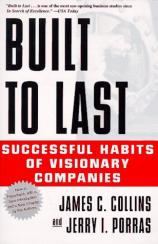Reading Group Guide
Discussion Questions
Built to Last: Successful Habits of Visionary Companies

1. Why do you think the authors chose to use the term "visionary" to describe the companies profiled in the book rather than "successful" or "great"?
2. The authors state that "as extraordinary as they are, the visionary companies do not have perfect, unblemished records" and then cite specific examples: Walt Disney faced a serious cash flow crisis in 1939 which forced it to go public. Boeing had serious difficulties in the mid-1930s, the late 1940s, and again in the 1970s when it laid off over sixty thousand employees. What allowed these two and the other visionary companies to bounce back from severe adversity?
3. Myth number one debunked in the book is that "it takes a great idea to start a great company." Do you agree that this is a myth? Cite some examples of visionary companies that did not start with a great idea. Discuss the other myths that the authors "shatter."
4. The authors quote Bill Hewlett of Hewlett-Packard as saying, "When I talk to business schools occasionally, the professor of management is devastated when I say that we didn't have any plans when we started-we were just opportunistic. We did anything that would bring in a nickel." Why do you think this is a disconcerting notion to many people, in this particular case to management professors? What is that they want to hear?
5. Which of the visionary companies do you think is the most successful, and why? How do its business practices differ from its "comparison" company?
6. The authors believe their findings "will apply more in the twenty-first century than in the twentieth. In particular, the essential ideas to come from our work…will continue to be key concepts long into the future." Do you agree that their findings will endure well into the future? Are any of the "visionary" companies, in your opinion, not as successful today as they were when the authors first wrote about them in 1995?
Built to Last: Successful Habits of Visionary Companies
- Publication Date: January 15, 1997
- Paperback: 368 pages
- Publisher: HarperBusiness
- ISBN-10: 0887307396
- ISBN-13: 9780887307393







